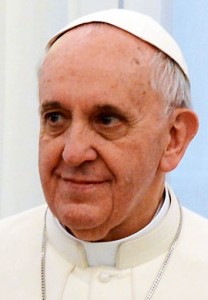 The Nicene Creed each week reminds us that when we invoke our Catholic (n.) faith, we declare unity with the church in its all-embracing oneness – our catholic (adj.) existence. As Father Robert Barron has made clear on occasion, the word catholic, traced back from the Greek, means something along the lines of “according to the whole.” Another translation would be closer to “throughout the whole.”
The Nicene Creed each week reminds us that when we invoke our Catholic (n.) faith, we declare unity with the church in its all-embracing oneness – our catholic (adj.) existence. As Father Robert Barron has made clear on occasion, the word catholic, traced back from the Greek, means something along the lines of “according to the whole.” Another translation would be closer to “throughout the whole.”
Although the word catholic is often used today to denote a church which is universal, there is some authority for the notion that the Church fathers, indoctrinated in Latin, intentionally chose the Greek word katholikos when crafting the Nicene Creed, instead of the more direct Latin word universalis, in order to highlight an important distinction.
Where a universal church might be thought of as one which has set exclusive boundaries between itself and the outside world (“constantly concerned about who is in and who is out” of that bounded universe), a katholikos church would ultimately be considered more
inclusive because it is to be found without separation from, but instead exists as part of the world and society. Those who talk about the church as in the world and not apart from it, follow in the pathway of the Second Vatican Council’s document Gaudium et Spes, “The Pastoral Constitution of the Church in the World.”
And so it is this more inclusive, second definition – katholikos – to which I now turn as I describe the The Armed Man concert I attended today at a Unitarian Congregation in Manhasset, New York – where I had the pleasure of listening to my wife participate in the chorus.
The Armed Man, A Mass For Peace, composed by Karl Jenkins in 1999 for the new millennium, was commissioned by the Royal Armouries Museum, and was dedicated to the victims of Kosovo.
It is
essentially an anti-war piece and is based on the Catholic Mass, which Jenkins combines with other sources . . . The Armed Man charts the growing menace of a descent into war, interspersed with moments of reflection; shows the horrors that war brings; and ends with the hope for peace in a new millennium, when “sorrow, pain and death can be overcome.”
Interestingly – and ironically – the piece was first released on September 10, 2001.
The piece incorporates an Islamic Call to Prayers, the writings of Rudyard Kipling, Alfred Lord Tennyson, Jonathan Swift, and Sankichi Toge (a poet and a survivor of the atomic bombing of Hiroshima), and includes excerpts from the Ordinary of the Mass, the Psalms, and Revelation.
It is, in short, a catholic prayer for peace, for it is a call for peace in this world, for all peoples, for all times, in all places.
From the words of Kryrie (familiar to all Catholics, Kyrie eleison, Christie eleison, Kyrie eleison – “Lord Have Mercy, Christ Have Mercy, Lord Have Mercy”), to Agnus Dei, to Sanctus, to Benedictus, one could easily feel transported in time, in place, and in being.
Yet, the piece connects us all.
For we are all part of every man, every woman, every child.
And we exist within every political sub-division, under every economic order, and throughout every era.
We are one.
While the concert I attended is not yet available on video, I’ve inserted just below a YouTube version of Kyrie that you might enjoy – The London Philharmonic Orchestra, 2009:
In light of the increasing troubles, wars and rumors of wars, the message of The Armed Man remains timely.
It is perhaps even more timely today than it was when it was composed in a pre-September 11 era.
If you are interested, here is a complete version available on YouTube – The Northeastern Spring Choir Concert, April 2014, Boston:
Peace
Photo Image Credit: Flyer from The Unitarian Universalist Congregation at Shelter Rock, Manhasset, NY












